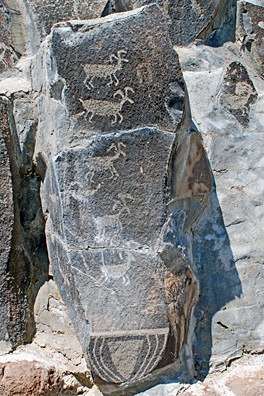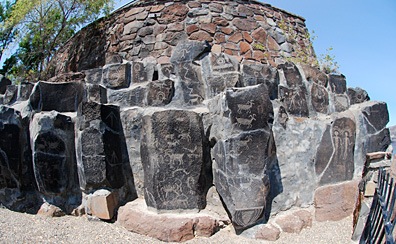Tales of New Year’s Eves gone by.
I remember when I was a kid, thinking about the turn of the century, which would also usher in a new millennium. I remember calculating how old I’d be when that day came: 39. Wow! That was old! But here it is, eight years later, and I’m well past that. Yes, 40-something — you do the math — is old to an 8-year-old, but it isn’t very old when you’re 40-something.
Back in those days, we spent our New Year’s Eves at our neighbor’s house. The Merrifields were a family of 8 who lived in a big house on the hill across the street. Their 2+ acres was surrounded by trees and shrubs, making their house impossible to see from ours during the summer months. But in the winter, when the trees were bare, you could see it through the gray branches: a huge wooden structure with a big front porch, with white paint in desperate need of refreshing.
Mr. Merrifield was not a handyman. He was a scientist. I didn’t know where he worked or exactly what he did. But I do know that years later, after we’d moved away, he won the Nobel Prize for chemistry. So you really can’t fault him if his house needed a paint job.
Mrs. Merrifield was heavily involved in a number of activities with her five girls and one boy. Like my mother, she was a Girl Scout leader. And every year, she’d host a New Year’s Eve party for all the neighborhood kids. We go over there in the evening and hang out in the back room — a sun porch that had been converted into a good-sized TV room. The TV would be on with various New Year’s Eve programming for us. Maybe a movie early in the evening. But always Dick Clark as midnight neared.
Then, at the golden hour, after counting down together, we’d take pots and pans and wooden spoons and run outside in the cold. We’d bang the pots and scream out “Happy New Year” for the next ten or fifteen minutes, making quite a racket in the neighborhood. No one seemed to mind in those days. It was just something people did. Afterwards, we’d go home to bed.
One year, my sister or I — I honestly can’t remember which — ruined one of my mother’s pots by banging dents into it.
Another year, my sister and I had a fight before the party. I grabbed something to throw at her, which just happened to be a glass of grape juice sitting on my night table. I missed her and hit her brand new bedspread. Boy, did I get into trouble for that one. My mother never got the stain out. We didn’t go to the party that year.
There’s a gap in my memory of New Year’s Eves after that. My parents split and we moved away to Long Island. No more neighborhood parties.
It wasn’t until I started dating that New Year’s Eve started getting special again. Then it was getting some kind of New Year’s “package” at a catering hall offering those kinds of things. Usually a buffet meal, cash bar, and warm, flat champagne (poured hours before) at midnight. Always a dress-up affair, sometimes involving a limo with another couple to and from the festivities. It was a big deal in those days, but it may have started my distaste for packaged and programmed entertainment.
Over the years, it’s been more of the same. Nothing very memorable — perhaps because of over-consumption of alcohol. (Can someone explain why you people to get shitfaced to ring in the new year?) The years rolled by.
As we matured, we switched to a New Year’s Eve routine that included a nice dinner out followed by an evening at home with a bottle of champagne. Television fell of the equation, replaced by conversation. I recall a particularly nice New Year’s Eve when we lived in New Jersey: dinner at our favorite Japanese restaurant where the staff somehow made its few customers feel special. And the champagne at home is always high-quality and ice cold.
When we moved to Wickenburg, we started having New Year’s Eve dinner at home. There simply wasn’t anything better in town to do, and, with all the animals we have, going down to Phoenix for an overnight was not an easy option.
Last year, we managed to get reservations at a local guest ranch. The food was good, but they placed us in a room with a party of 15 or 20 that included kids. Not exactly the quiet evening we’d envisioned, but the food was good and the service was quite acceptable.
This year, we returned to the ranch for New Year’s Eve dinner on the house. I’d done some work for the ranch, flying the manager and a photographer over the ranch to take photos from the air. Rather than get paid, I agreed to a trade — my flight time for New Year’s Eve dinner. The arrangements were made months ago, in the spring. Since then, the ranch manager moved on to other things. But I reminded the ranch owner a few months ago and, on Sunday, when I called to make reservations, learned that we’d already been put on the reservations list.
Although I do appreciate a free meal, I admit that I was deeply disappointed this year. Although the ranch is normally the best restaurant in town, they set up a buffet with a limited number of choices: a prime rib carving table, poached salmon, and a shrimp and chicken pasta dish. The place was full of people of all ages, walking back and forth from table to buffet line to get each course. Some of the folks were very old and needed help getting their plates back. And some of the kids were a bit rambunctious. It was loud, but not because of music — it was sheer voices. If you needed something that wasn’t at your table or on the buffet tables — like butter — you had to flag down a waiter or waitress. Certainly not the meal I was expecting.
I shouldn’t be so critical of the atmosphere. It’s supposed to be a party, a celebration of the new year. But I prefer to let the old year die quietly and the new year slip in to take its place. Each new year is another year gone. There are only a limited number of years in a person’s life.
Perhaps that’s why I think back to the days on Mezzine Drive — now Merrifield Way — in Cresskill, NJ and the New Year’s Eves banging pots out in the cold. Back then, each new year was a step closer to maturity and independence, a step closer to the day when I could step out into life on my own. Why not celebrate?
 The message was a combination history lesson and call for action. It began with the sentence, “This is the story of our Grandmothers and Great-grandmothers; they lived only 90 years ago.” I knew I was in for it when I saw a series of sepia-tinted photos of suffragettes on the march. I fully admit that I didn’t read the whole thing.
The message was a combination history lesson and call for action. It began with the sentence, “This is the story of our Grandmothers and Great-grandmothers; they lived only 90 years ago.” I knew I was in for it when I saw a series of sepia-tinted photos of suffragettes on the march. I fully admit that I didn’t read the whole thing.

 Around the side of the building is a display, behind an iron fence, of some petroglyphs that were rescued from floodwaters when the Wanapum dam was completed downriver in 1963. But to understand why the rocks these drawing appear on look so uniform, I need to discuss the geology of the area a bit.
Around the side of the building is a display, behind an iron fence, of some petroglyphs that were rescued from floodwaters when the Wanapum dam was completed downriver in 1963. But to understand why the rocks these drawing appear on look so uniform, I need to discuss the geology of the area a bit. From 1000 to 300 years ago, native people drew on these columns of dark rock near the river’s edge. There’s actually an impressive variety of petroglyph drawings. About 300 of them were physically moved from what would soon be Lake Wanapum to the side of the Interpretive Center at the park. That’s what I saw and what is pictured here. (And no, the building isn’t curved. I was using my silly fisheye lens in an effort to capture more petroglyphs in a tight space.)
From 1000 to 300 years ago, native people drew on these columns of dark rock near the river’s edge. There’s actually an impressive variety of petroglyph drawings. About 300 of them were physically moved from what would soon be Lake Wanapum to the side of the Interpretive Center at the park. That’s what I saw and what is pictured here. (And no, the building isn’t curved. I was using my silly fisheye lens in an effort to capture more petroglyphs in a tight space.) And then the main fireworks display began. It started at 10 PM sharp with a continuous display of large fireworks over the lake. Somehow, we’d managed to get a perfect spot in the park. We were both comfortable in our chairs and had unobstructed views. I’d brought along my camera and tripod in an attempt to capture some of the fireworks in pixels. This shot, taken with my fisheye lens, isn’t very good, but it gives you an idea of our surroundings: the people around us in the park, the water of the lake, a high tension powerline tower all illuminated by the rocket’s red glare.
And then the main fireworks display began. It started at 10 PM sharp with a continuous display of large fireworks over the lake. Somehow, we’d managed to get a perfect spot in the park. We were both comfortable in our chairs and had unobstructed views. I’d brought along my camera and tripod in an attempt to capture some of the fireworks in pixels. This shot, taken with my fisheye lens, isn’t very good, but it gives you an idea of our surroundings: the people around us in the park, the water of the lake, a high tension powerline tower all illuminated by the rocket’s red glare. On Saturday, after a long day on my feet as a volunteer for the Land of the Sun Endurance Ride here in Wickenburg, I found myself in front of the television. I flipped to one of the movie channels just as
On Saturday, after a long day on my feet as a volunteer for the Land of the Sun Endurance Ride here in Wickenburg, I found myself in front of the television. I flipped to one of the movie channels just as